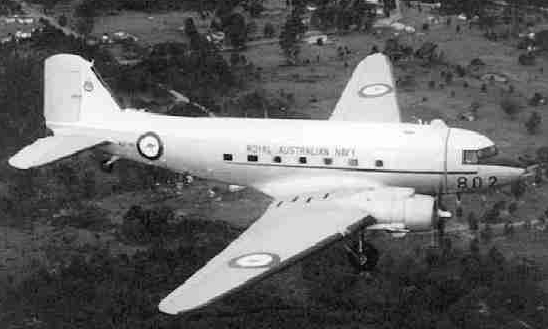- Author
- van Gelder, Commander John RAN (Rtd)
- Subjects
- Ship histories and stories
- Tags
-
- RAN Ships
- HMAS Albatross (Shore Establishment)
- Publication
- June 2003 edition of the Naval Historical Review (all rights reserved)
Post WW2, the RAN operated four Dakota aircraft from NAS Nowra for many years, and no doubt former FAA personnel will remember them with nostalgia, in a similar vein as recorded in the following account.
FOR THOSE WHO LIVED THROUGH THE LATE 1930s and through the 40s, 50s, 60s and probably even today the mention of the Douglas DC3 is synonymous with flying and air transport. Incredibly, even today television advertising tells us that we can have a ‘luxury’ tour over Sydney in a Dakota! For pilots who were fortunate to fly the aircraft it was more than just another aircraft, it became almost a way of life.
After about four years of successful airline service with the DC2 followed by the DC3 and with the rapid approach of war, the American armed services looked for a new reliable and robust transport aircraft. Modifications to the DC3 to suit it for military service were relatively simple. Some strengthening in the rear fuselage area, larger doors for cargo handling, an astrodome and uprated engines were basically all that was needed. In this way the military version of the aircraft was born and became known as the C47, referred to as the Douglas Skytrain by the Americans and the Dakota when they entered service in the British and Commonwealth services. In total, about 13,000 were built.
The longevity of the DC3s and C47s was due, no doubt, to an extremely sound and aesthetically pleasing design, and of particular significance, the inherent strength of the multi spar wing construction. The visual appearance of the Dakota seemed to inspire confidence.

The RAN operated four ex-RAAF Dakotas from HMAS Albatross between 1950 and the mid 1970s. Two were in service when I was invited to take more than just a casual interest in the aircraft in early 1957. The two aircraft were A65-43 and A65-23 with side numbers 800 and 801 respectively. The last two Dakotas transferred from the RAAF to the RAN were A65-90 and A65-123 and flown from RAAF Base East Sale to Nowra in February 1968. Their side numbers were 802 and 803 and I had the honour to deliver both aircraft from East Sale to Nowra.
In January 1957 I was enjoying myself flying Fireflys and Sea Furys from HMAS Albatross when I was bidden by the Director of Officers Appointments to take myself off to the RAAF Central Flying School at RAAF Base East Sale for a conversion course on Dakotas. This came as a complete surprise to me, but never one to disobey a direct order I travelled south and delivered myself unto the tender mercies of one Flight Lieutenant Robert ‘Snow’ Joske to be instructed in the intricacies of the legendary Dakota. ‘Snow’ Joske was an A1 category Qualified Flying Instructor and, perhaps, the most professional flying instructor I have ever known. Incidentally, Group Captain Joske RAAF (Rtd) is a good friend of mine to this day.
Two weeks concentrated flying the Dakota taught me many things I had not appreciated when flying single engine aircraft, but mainly how to fly a twin engine aircraft on one engine! It was very rarely in a training flight that one engine didn’t ‘accidentally’ fail because the instructor had surreptitiously turned off the fuel to an engine, and one found oneself like a one armed paper hanger trying to keep the aircraft flying with one hand and rectify the problem with the other whilst at the same time trying to complete a complex instrument homing or approach procedure.
In any flying training programme simply taking off and landing the aircraft and basic manoeuvres are the easy part. Where flying training is most important is in teaching the pilot how to overcome problems when things don’t go according to plan. That is the critical time when an emergency happens. If a military pilot does not concentrate every second he is in the air thinking about what may happen to his aircraft if unexpected things happen he is likely to die.
Since Dakotas were designed as a transport aircraft there was a fundamental requirement to fly them over relatively long distances in all but extreme weather conditions. For this reason Dakotas were fitted with de-icing equipment on the wings, propellers and windscreens. Additionally, the two RAN Dakotas, which were originally equipped only with radio compasses as a navigation aid, were upgraded in 1956/57 with Visual Aural Range (VAR) combined with Instrument Landing System (ILS) instrumentation. The addition of this equipment meant that the aircraft could now operate safely in the Civil Air Routes and could be flown into major civil airports in inclement or low cloud weather conditions. This also meant much more instrument flying practice and the need to become proficient in civil instrument approach procedures for the naval pilot. A type of flying in which he had very little previous experience.




